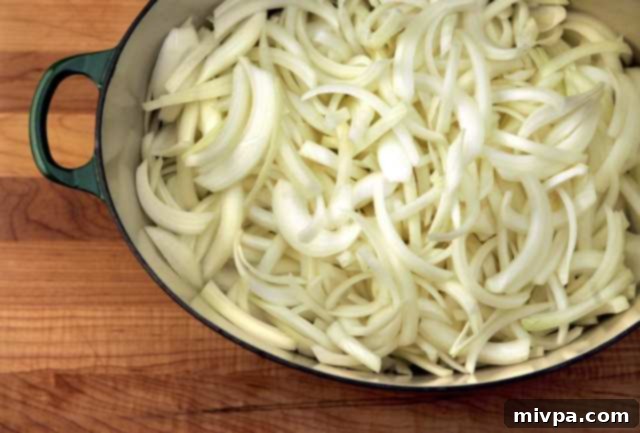How to Cut Onions Without Crying: The Ultimate Guide to Tear-Free Chopping
Onions are, without a doubt, a cornerstone of global cuisine. From the delicate stir-fries of Asia to the hearty stews of the Middle East and the classic French mirepoix, their pungent aroma and distinctive flavor are absolutely indispensable. Any home cook or professional chef will attest to their foundational role, often serving as the aromatic base that elevates a dish from simple to spectacular. Their versatility is unmatched, whether caramelized to a sweet, golden perfection, diced finely for a piquant salsa, or roughly chopped for a rustic soup. This humble vegetable, truly a gift from the garden, is central to so many of our favorite recipes.
Despite this deep appreciation and long-standing culinary relationship, onions present a universal challenge: the dreaded tears. For generations of cooks, the act of slicing, dicing, or chopping onions has been synonymous with watery eyes and an unpleasant stinging sensation. It’s a culinary paradox – a fundamental ingredient that brings joy to the palate but often brings discomfort to the eyes. Many have tried various folk remedies and personal techniques, only to find themselves still reaching for a tissue. This involuntary reaction can make cooking feel less like a pleasure and more like a chore. But what if there was a way to enjoy the process of preparing onions without the accompanying sorrow? This guide will delve into the science behind the tears and, more importantly, equip you with proven, practical methods to make your onion-chopping sessions truly tear-free.
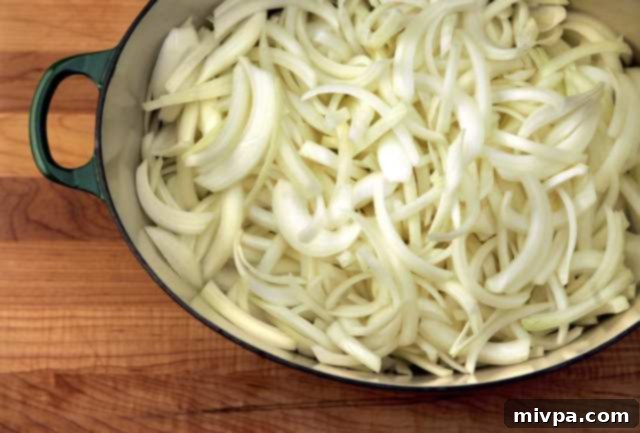
The Science Behind the Tears: Why Onions Make You Cry
Understanding why onions make us cry is the first step toward preventing it. It’s not a malicious trick by the vegetable; rather, it’s a fascinating chemical defense mechanism. When an onion is intact, its cells contain two key components stored separately: enzymes (specifically alliinase and lachrymatory factor synthase) and sulfur-containing compounds (called LFS precursors or amino acid sulfoxides). The problem arises when you cut into the onion.
Breaking Down the Tear-Inducing Reaction:
- Cell Damage and Enzyme Release: When you slice through an onion, you rupture its cells. This breakage allows the previously separated enzymes and sulfur compounds to mix.
- Chemical Transformation: The alliinase enzyme rapidly converts the sulfur-containing compounds into sulfenic acids. These acids are unstable and quickly rearrange.
- Lachrymatory Factor Synthase (LFS) Takes Over: Another enzyme, lachrymatory factor synthase, then acts on these sulfenic acids, converting them into a volatile gas called syn-propanethial S-oxide. This is the lachrymatory factor (LF) – the chemical culprit responsible for your tears.
- Gas Reaches Your Eyes: As this gas is released into the air, it drifts towards your eyes.
- Acid Formation in Your Eyes: When syn-propanethial S-oxide comes into contact with the water (tears) on the surface of your eyes, it reacts to form a mild sulfuric acid.
- Irritation and Tears: This sulfuric acid irritates the nerve endings in your eyes, triggering your body’s natural defense mechanism: tear production. Your eyes produce more tears to try and wash away the irritant, leading to the familiar stinging, burning sensation and excessive watering.
This intricate biochemical process explains why you often feel the sting more intensely the longer you chop or the more onions you process. The continuous release of these compounds keeps irritating your eyes.
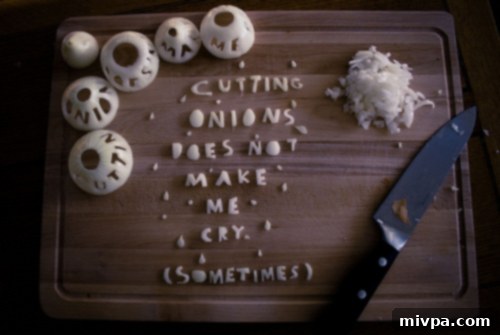
Picture source: www.made-in-england.org
Effective Strategies to Chop Onions Without Tears
Now that we understand the enemy, let’s explore the arsenal of techniques to combat it. These practical methods, many inspired by culinary experts and scientific studies, aim to either minimize the release of the tear-inducing gas, create a barrier, or neutralize the compounds before they can irritate your eyes. By implementing one or a combination of these strategies, you can transform your onion-prepping experience into a much more pleasant one.
Here are some highly effective methods to keep your onion-chopping sessions tear-free and enjoyable, ensuring you can embrace the flavor without the fuss:
1. Use a Very Sharp Knife
This is arguably one of the most fundamental and effective tips. The enzymes responsible for creating the lachrymatory factor are released when onion cells are ruptured or crushed. A dull knife tears and smashes the cells, causing widespread damage and maximizing the release of these enzymes and sulfur compounds. In contrast, a razor-sharp knife glides cleanly through the onion, slicing through cells rather than crushing them. This minimizes cellular damage and, consequently, significantly reduces the amount of tear-inducing gas released into the air. Regularly sharpen your knives; not only will it save your eyes, but it will also make all your chopping tasks safer and more efficient.
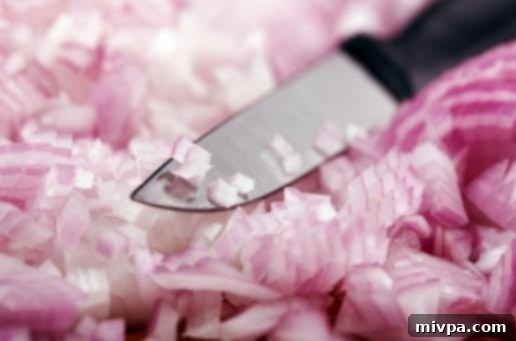
2. Chill the Onions Before Cutting Them
Temperature plays a crucial role in chemical reactions. Chilling your onions before cutting them can dramatically reduce the volatility of the lachrymatory factor synthase and the other reactive compounds. Placing your onions in the freezer for 10-15 minutes, or in the refrigerator for 30 minutes to an hour, slows down the enzymatic reactions that produce the irritant gas. The colder temperature makes the gas less prone to evaporating and becoming airborne. This method was notably highlighted by the television program “Food Detectives” as one of the most effective ways to reduce tears, making it a scientifically backed approach for many home cooks.
3. Create a Physical Barrier or Ensure Proper Ventilation
If you can prevent the gas from reaching your eyes, you win the battle. There are several ways to achieve this:
- Wear Protective Eyewear: Gas-tight goggles, often referred to as “onion goggles” or even swimming goggles, create an impenetrable barrier between your eyes and the airborne irritants. For those who wear contact lenses, these can also offer a partial barrier, but dedicated goggles are far more effective.
- Utilize Ventilation: Cut your onions next to a strong draft. Positioning yourself near an open window, directly under a powerful kitchen range hood, or in front of a small fan will cause the tear-inducing gas to be directed away from your face and eyes. Good airflow is key to dispersing the compounds before they can reach you.
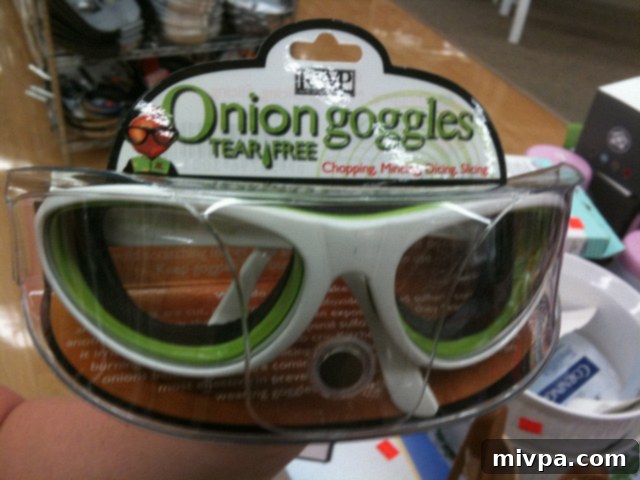
4. Absorb the Gas in Water
The lachrymatory factor is water-soluble. By introducing water into the environment where you’re cutting, you can dissolve the gas before it has a chance to reach and irritate your eyes. This can be achieved in a few ways:
- Cut Under Running Water: While somewhat awkward and potentially messy, chopping onions under a gentle stream of running water is highly effective. The water immediately washes away the irritants.
- Cut Near Running Water or a Cloud of Steam: The ambient moisture from a nearby running tap or a pot of simmering water can help absorb the airborne compounds, reducing their concentration around your face.
- Submerge in Water: Some chefs advocate for peeling and roughly chopping onions while they are submerged in a bowl of water. This is particularly effective for dicing, though it can make the onion slices a bit slippery.
5. Slow Down or Stop the Gas-Producing Reaction
Several substances can interfere with the enzymatic reaction that produces the lachrymatory factor:
- Vinegar on the Chopping Board: The acidity of vinegar can denature (alter the structure and function of) the enzymes responsible for the tear-inducing reaction. Wipe your chopping board with white vinegar before you start, or even dab a little on the cut surfaces of the onion.
- Soak Onions in Water: Soaking peeled and halved onions in water for 15-20 minutes before cutting them helps to wash away some of the enzymes and sulfur compounds. The water-air boundary also helps to denature some of the enzymes, reducing their activity.
- Soak Onions in Saltwater: Similar to plain water, a saline solution can also help to denature the enzymes due to its ionic properties. A quick soak in lightly salted water can be an effective pre-treatment.
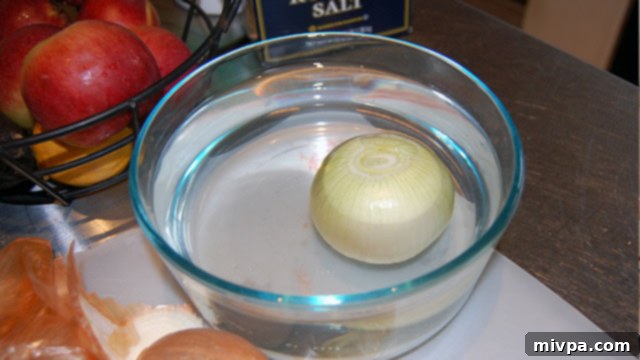
6. Cut the Root End Last
The root end of the onion is where the concentration of sulfur compounds is highest. Many culinary experts recommend cutting off the top of the onion, peeling it, making your desired cuts (dicing, slicing) while leaving the root end intact, and only severing the root when all other chopping is complete. This minimizes the release of the most potent irritants until the very last moment, and you can quickly dispose of the root once cut.
For more detailed instructions and visual guides on many of these techniques, you can explore resources like Wikihow.com’s guide on chopping onions without tears.
Combining Methods for Optimal Tear-Free Chopping
While each of these methods offers significant relief individually, the most effective approach often involves combining a few techniques. For instance, you might start by chilling your onions in the freezer for 15 minutes, then use a freshly sharpened knife to chop them under a running range hood. Or, you could soak your onions in cold water, then make your cuts with goggles on. Experiment with different combinations to find what works best for your kitchen setup and personal comfort level. By strategically layering these methods, you can create a highly effective defense against onion tears.
Embrace Tear-Free Cooking
Onions are truly indispensable in the kitchen, offering layers of flavor that can transform any meal. The good news is that you no longer have to endure tearful cooking sessions to enjoy their culinary benefits. By understanding the science behind the tears and applying these practical, scientifically-backed strategies, you can confidently chop, dice, and slice without discomfort. Embrace the joy of cooking with onions, knowing that your eyes will remain dry and your focus can stay entirely on creating delicious food. Happy chopping!
